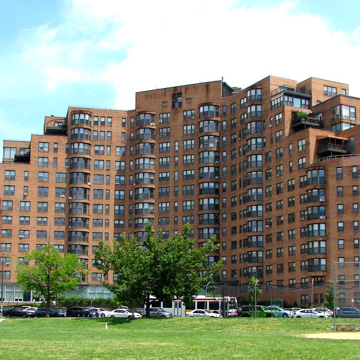The apartment houses along the northern edge of Benjamin Franklin Parkway form a modernist response to the Beaux-Arts civic buildings below. The Parkway House is exceptionally dynamic, the splayed Y of its plan maximizing light, air, and views for the apartments. At the same time, its dark brick hue and modern detailing recall Raymond Hood's New York City work of the 1930s, marrying streamlining and International Style asceticism. It makes a lively juxtaposition with the nearby Philadelphian at 2401 Pennsylvania Avenue (1959–1963, Samuel Oshiver), which brings the energy of Morris Lapidus's Miami and New York City high-rises to the Parkway. Unlike Oshiver's earlier apartment houses on Rittenhouse Square, The Philadelphian explicitly addresses the role of the automobile by placing a grand porte-cochere at its center. The result is unusually frisky even in a neighborhood of jaunty apartment houses, such as
You are here
Parkway House
1952–1953, Elizabeth Fleisher and Gabriel Roth. 2201 Pennsylvania Ave.
If SAH Archipedia has been useful to you, please consider supporting it.
SAH Archipedia tells the story of the United States through its buildings, landscapes, and cities. This freely available resource empowers the public with authoritative knowledge that deepens their understanding and appreciation of the built environment. But the Society of Architectural Historians, which created SAH Archipedia with University of Virginia Press, needs your support to maintain the high-caliber research, writing, photography, cartography, editing, design, and programming that make SAH Archipedia a trusted online resource available to all who value the history of place, heritage tourism, and learning.


